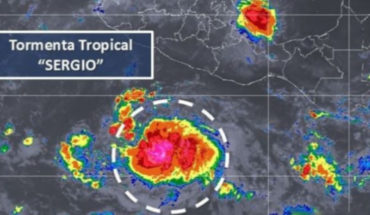By 2019, the state government of Quintana Roo foresees that a million tons of sargasso will be collected from the sea and beaches, flooding multiple points on the Caribbean coast, 100% more than the 500 thousand tons it collected in 2018.
Despite these figures and the atypical increase in this algae in waters throughout the Caribbean in 2019, the State Tourism Secretariat (Sedetur) ensured that the nearly 4 million tourists who have already confirmed for this summer season will find that “most of the pl ayas are clean” of sargasso.
They find the world’s largest “sargavour belt” floating in the Gulf of Mexico
“Neither every day nor on all the beaches there is a presence of sargasso,” stressed Marisol Vanegas, Secretary of Tourism of Quintana Roo, who explained that they are working to clean up the coasts of the Mexican Caribbean, along with the private sector, the town halls, civil organizations, and the Navy, which last Monday reported that it has already collected 155 tons of sargasso on the high seas.
“Many of the beaches are in excellent condition. All Cancun, all Cozumel, the entire mainland of Isla Mujeres, and much of the Riviera Maya. I would say that more than 100 or 200 kilometers of Riviera Maya are clean,” she said in an interview with Political Animal, in which he noted that, on a daily basis, the Sedetur publishes on its social networks a report with webcam images of the beaches.
“We also had images of the beaches of Tulum and very well Tulum. In fact, on almost the entire Mexican Caribbean front you will find, in virtually any of the destinations, that most of the beaches are clean,” Vanegas added.
However, this contrasts with the images of multiple beaches affected by the sargasso, which the Ministry of Tourism itself publishes daily on its social networks.
Staff of the company Grupo Arco work in the work of cleaning the public beaches of Playa Del Carmen. Picture taken on Wednesday, July 3
More than 26 thousand tons of sargasso have been removed from Mexican beaches: Secretariat of Marina
For example, although the official said that Tulum “is fine”, the images published throughout this week by the Sedetur show areas where the sargasso accumulates several meters in the hotel zone and also in the area of the archaeological ruins, one of the largest tourist attractions of Quintana Roo.
Other areas affected by the sargasso, according to the Sedetur’s own report, are Akumal and Xcalac, south of the entity, already on the border with Belize.
Political Animal He also took a tour of Playa Del Carmen, in the municipality of Solidaridad, and found that there are strong effects by sargasso both in the hotel area of Playacar, and on the public beach of the docks, where intense cleaning work is already carried out.
In Cancun, in Playa Coral, as well as in Puerto Morelos, there was also a strong presence of sargasso.
Check out the report here published by Sectur on Thursday, July 11
Image taken on Wednesday, July 3 on a political animal tour of the public beach of Playa Del Carmen, in the municipality of Solidaridad, Quintana Roo.
Affectations on most beaches
The civil organization Cancun Sargasso Monitoring Network has also posted on its Facebook profile photographs and videos taken with drones that contrast with the Sectur report.
For example, this week he published images that account for the arrival of sargasso on the beaches of Cancun’s hotel zone, north of Quintana Roo; one of the areas that, until now, had not received so much sargasso.
In fact, the Monitoring Network, which makes its daily reports of the evolution of the sargasso based on satellite images from the Optical Oceanography Laboratory of the University of South Florida, and the Marine Monitoring System of the National Commission for Biodiversity, reported that multiple beaches of Quintana Roo present, to this day, important impacts by this algae.
Areas that present “excessive” sargasso arrival are concentrated in Tulum and Cozumel, on the coast opposite Playa Del Carmen, that is, in Punta Celarain, Playa Bush, Playa San Martín, Playa Chen Río, Playa Mezcalitos, Playa Bonita, and Punta Molas.
Other areas marked with “abundant” sargasso are Puerto Morelos, Playa Paraíso, Punta Maroma, Puerto Aventuras, Xpu-Ha, Bahía Príncipe, Playacar, Moon Palace, Riviera Cancun, and the aforementioned Playa Del Carmen.
While Punta Sam, Playa del Niño, Puerto Juárez and Cancun Norte, present “moderate” arrival of sargasso.
Staff of the company Grupo Arco work in the work of cleaning the public beaches of Playa Del Carmen. Picture taken on Wednesday, July 3.
Sargasso in Quintana Roo has been magnified to affect the new government: AMLO
On the contrary, the coast of Cozumel that is in front of Playa Del Carmen, is one of the few marked areas with a “low” arrival of sargasso: Cozumel Norte, Cozumel Centro, Chankanaab Beach, Playa Mia, Playa Palancar and El Cielo.
In the north of Quintana Roo, other areas with a “low” sargasso presence are: Punta Mosquito, Holbox Centro, Punta Cocos, Isla Mujeres Norte and sur, Punta Nizuc, and Isla Contoy.
Until this Thursday’s cut, 15 of the 44 beaches monitored in the Monitoring Network reports have a “low” concentration of sargasso.
The rest, have moderate, abundant or excessive presence of sargasso.
“In the north of Cancun where, so far, the presence of sargasso has been felt less. On the contrary, in the southern part, from Xcalac, through all that is Tulum, Mahahual, and the east coast of Cozumel, is where the greatest impact has been recorded,” summed up Esteban Amaro, hydrobiologist and technical director of the Cancun Sargasgas monitoring network , who warned that Mexico is facing one of the most serious environmental problems in its history.
“No tourist catastrophe”
For his part, Quintana Roo’s Secretary of Tourism Marisol Vanegas admitted that sargasso “is a serious problem”, although he ruled out that the state faces “a tourist catastrophe”.
“There is much more to be done on this subject,” he conceded. “But this summer season we will receive almost 4 million visitors already confirmed with the airlines that will surely have a great time, because, in addition to the beaches, Quintana Roo offers many other tourist attractions, such as archaeological areas, cenotes, and nature parks,” stressed the tourism headline.
What we do in Animal Político requires professional journalists, teamwork, dialogue with readers and something very important: independence. You can help us keep going. Be part of the team.
Subscribe to Animal Politician, receive benefits and support free journalism.#YoSoyAnimal
translated from Spanish: QRoo authorities before sargasso
July 12, 2019 |





